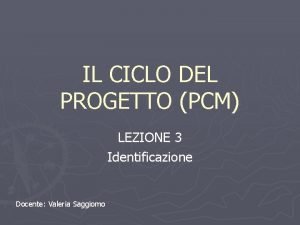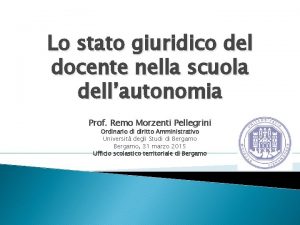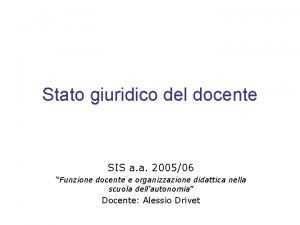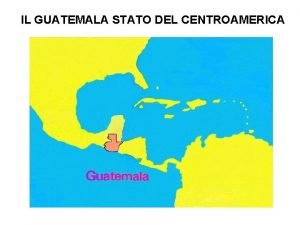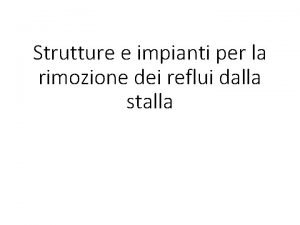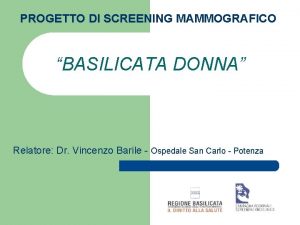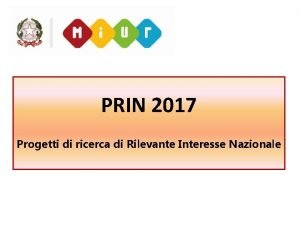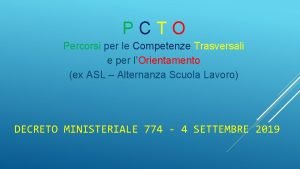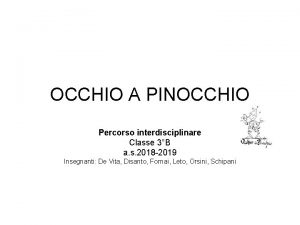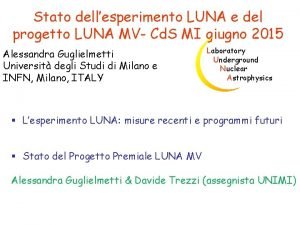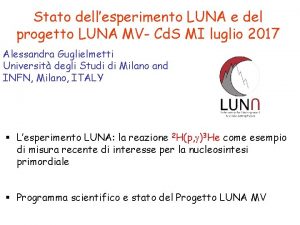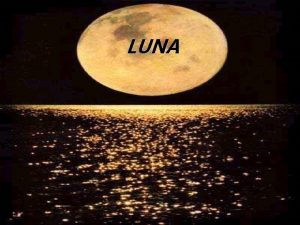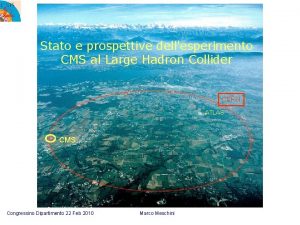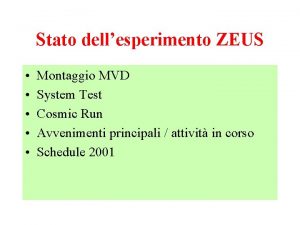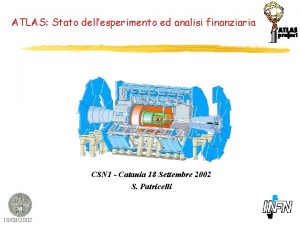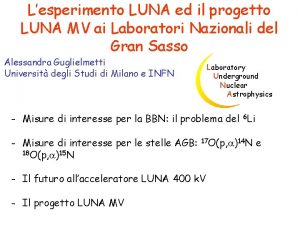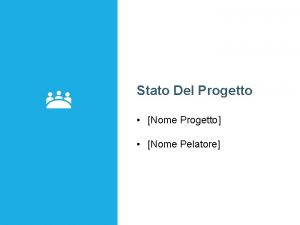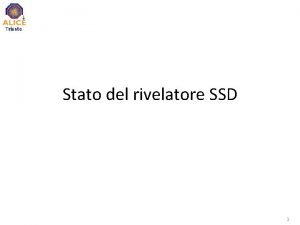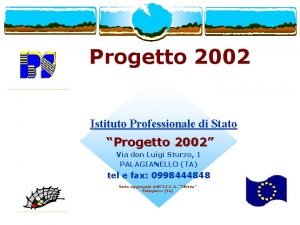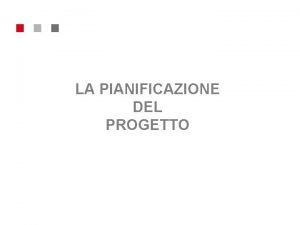Stato dellesperimento LUNA e del progetto LUNA MV












![The 13 C(a, n)16 O reaction S [Me. V b] E = 140 -230 The 13 C(a, n)16 O reaction S [Me. V b] E = 140 -230](https://slidetodoc.com/presentation_image/3b95915cf7c5a23ba24d1a37c4d4e85d/image-13.jpg)




- Slides: 17

Stato dell’esperimento LUNA e del progetto LUNA MV- Cd. S MI luglio 2017 Alessandra Guglielmetti Università degli Studi di Milano and INFN, Milano, ITALY § L’esperimento LUNA: la reazione 2 H(p, g)3 He come esempio di misura recente di interesse per la nucleosintesi primordiale § Programma scientifico e stato del Progetto LUNA MV

2 H(p, g)3 He measurement From: • the cosmological parameters • the cross section of the processes responsible for 2 H creation and destruction At BBN energies very few data on 2 H(p, g)3 He and 10% uncertainty Primordial deuterium abundance can be calculated BBN results can be compared with astronomical observations:

2 H(p, g)3 He measurement BGO phase: total cross section (50 -400 ke. V). D 2 pressure 0. 3 mbar HPGe phase: (150 -400 ke. V) D 2 pressure 0. 3 mbar Also angular distribution measurement with extended gas target (Now on-line) Laurea magistrale G. Zorzi Milano

2 H(p, g)3 He measurement About 5% uncertainty

From Hydrogen burning to Helium and Carbon burning or… from LUNA to LUNA MV A new 3. 5 MV accelerator will be installed soon in the north part of Hall B at Gran Sasso which is now being cleared

The LUNA MV accelerator In-line Cockcroft Walton accelerator In the energy range 0. 3 -3. 5 Me. V H+ beam: 500 -1000 em. A He+ beam: 300 -500 em. A C+ beam: 100 -150 em. A C++ beam: 100 em. A Beam energy reproducibility : 10 -4 * TV or 50 V The accelerator hall will be shielded by 80 cm thick concrete walls: no perturbation of the LNGS natural neutron flux

The scientific program of LUNA MV for the first 5 years (2019 -2023) 14 N(p, g)15 O: the bottleneck reaction of the CNO cycle in connection with the solar abundance problem. Also commissioning measurement for the LUNA MV facility 12 C+12 C: energy production and nucleosynthesis in Carbon burning. Global chemical evolution of the Universe coordinated by A. Guglielmetti 13 C(a, n)16 O and 22 Ne(a, n)25 Mg : neutron sources for the sprocess (nucleosynthesis beyond Fe) Later on… 12 C(a, g)16 O: key reaction of Helium burning: determines C/O ratio and stellar evolution

The 14 N(p, g)15 O reaction Three different measurements already performed at LUNA 400 k. V in the energy range 70 -370 ke. V (the third with a Clover detector above the 259 ke. V resonance) In 2016 measured by Li et al. over a wide energy range Still a complete and clear picture is not available: A low background measurement over a wide energy range is highly desirable to reduce the present uncertainty of 7. 5% on the S factor The cross section of the 14 N(p, g)15 O reaction is one of the main contributor in the global uncertainty on the SSM model prediction for the solar composition Li et al. , PRC (2016) n(CNO) depends on S 1, 14 and (C+N) abundance in the core: a measurement with 10% uncertainty would allow a determination of the (C+N) abundance at 15%

The 12 C+12 C reaction: astrophysical impact 12 C+12 C 20 Ne + a Q = 4. 62 Me. V 12 C+12 C 23 Na + p Q = 2. 24 Me. V 12 C+12 C 24 Mg + g Q = 13. 93 Me. V negligible 12 C+12 C 23 Mg + n Q = -2. 62 Me. V endothermic for low energies 12 C+12 C 16 O + 2 a Q = -0. 12 Me. V three particles reduced prob. 12 C+12 C 16 O + 8 Be Q= -0. 21 Me. V higher Coulomb barrier: EC= 6. 7 Me. V Its rate determines the value of “Mup”: If Mstar>Mup: quiescent Carbon burning core-collapse supernovae, neutron stars, stellar mass black holes If Mstar<Mup: no Carbon burning white dwarfs, nova, type Ia supernovae The reaction produces protons and alphas in a hot environment nucleosynthesis in massive stars

The 12 C+12 C reaction: measurement strategy Quiescent carbon burning: 0. 9 Me. V<ECM<3. 4 Me. V Type Ia supernovae: ECM ≥ 0. 7 Me. V 12 C+12 C 20 Ne + a i + gi 12 C+12 C 23 Na + p i + gi Eg = 440 ke. V Eg = 1634 ke. V Particle detection: Si or DE/E telescopes Gamma detection: Hp. Ge At LUNA MV the g natural background can be reduced by 5 o. o. m.

The 12 C+12 C reaction at LUNA MV T. Spillane et al, PRL (2007) Several resonances spaced by 300 -500 ke. V Typical width G≈ 10 ke. V 1 mm thick C target and well shielded Hp. Ge detector: search for low energy resonances with 5 ke. V spacing and 30% statistical uncertainty: Beam induced background from 1 H and 2 H contamination in the target to be investigated E > 1955 for the proton channel (background limited) E > 1605 ke. V for the alpha channel (time limited) Total time needed 2. 5 y

The neutron source reactions for the s-process: 13 C(a, n)16 O and 22 Ne(a, n)25 Mg Nucleosynthesis of half of the elements heavier than Fe Main s-process ~90<A<210 Weak s-process A<~90 TP-AGB stars massive stars > 10 MSun shell H-burning T 9 ~ 0. 1 K 107 -108 cm-3 He-flash 0. 25 ≤ T 9 ~ 0. 4 K 1010 -1011 cm-3 13 C(a, n)16 O 22 Ne(a, n)25 Mg 13 C(a, n) 22 Ne(a, n) core He-burning 3 -3. 5· 108 K 106 cm-3 shell C-burning ~109 K 1011 -1012 cm-3 22 Ne(a, n)25 Mg
![The 13 Ca n16 O reaction S Me V b E 140 230 The 13 C(a, n)16 O reaction S [Me. V b] E = 140 -230](https://slidetodoc.com/presentation_image/3b95915cf7c5a23ba24d1a37c4d4e85d/image-13.jpg)
The 13 C(a, n)16 O reaction S [Me. V b] E = 140 -230 ke. V (T = 90 · 106 K) ´ 6 6 10 large statistical uncertainties at low energies large scatter in absolute values (normalization problem) unknown systematic uncertainties in detection efficiencies contribution from sub-threshold state (E=6. 356 Me. V in 17 O) contribution from electron screening Davids 1968 Bair 1973 Kellogg 1989 Drotleff 1993 Harrissopulos 2005 Heil 2008 5 4 fits/theory Hale 1987 Kubono 2003 Heil 2008 3 2 1 0 0. 1 0. 2 0. 3 LUNA 400 range 0. 4 0. 5 0. 6 0. 7 0. 8 0. 9 1. 0 1. 1 Ec. m. [Me. V] No data at low energy because of high neutron background in surface laboratories. Extrapolations differ by a factor ~4 (10% accuracy would be required).

The 13 C(a, n)16 O reaction at LUNA 400 and LUNA MV Direct kinematics (4 He beam on 13 C target): 210 ke. V<Ecm<300 ke. V (275 ke. V<Ebeam<400 ke. V) at LUNA 400 k. V 240 ke. V<Ecm<1060 ke. V (300 ke. V<Ebeam<1. 4 Me. V) at LUNA MV 13 CH gas target (drawbacks: limit on the density, possible molecule 4 cracking). With typical conditions: 2. 5 1017 atoms/cm 2 13 C enriched solid target (drawbacks: degradation, possible carbon deposition). Typically 2 1017 -1018 atoms/cm 2 Beam induced background: (a, n) reaction on impurities (10 B, 11 B, 17 O, 18 O) in the target and beam line En = 2 -3. 5 Me. V 3 He counters embedded in a polyethylene matrix Inverse kinematics (13 C beam on 4 He target): only possible at LUNA MV 4 He gas target 2. 5 1017 atoms/cm 2 Beam induced background: 13 C induced reaction on 2 H, 6 Li, 7 Li, 10 B, 11 B, 16 O, 19 F En = 2 -5. 5 Me. V: same detector as above

The 22 Ne(a, n)25 Mg reaction Q=-478 ke. V Level scheme of 26 Mg is very complex The lowest well studied resonance at Ea=832 ke. V dominates the rate The influence of a possible resonance at 635 ke. V has been ruled out because of parity conservation Only upper limits (~10 pb) at: 570<Ea<800 ke. V (energy region of interest for AGB stars) Extrapolations may be affected by unknown resonances At T 9 < 0. 18 the competing reaction 22 Ne(a, g)26 Mg (Q=10. 6 Me. V) should become dominant (now measured at LUNA 400 k. V) At LUNA MV: 22 Ne windowless gas target + 3 He counters inside moderator To fully exploit LNGS low background: shielded detector, selected tubes, pulse shape discrimination, remove 11 B (because of 11 B(a, n)14 N) to reach the level of ~10 n/day.

LUNA-MV : most probable schedule Action Date Approval of the first HVEE technical design October 2016 Opening of the tendering procedure for LUNA-MV plants November 2016 Submission of the Authorization request to «Prefettura dell’Aquila» December 2016 Beginning of the clearing works in Hall B February 2017 End of the tendering procedure for the new LUNA-MV building June 2017 Beginning of the construction works in Hall B DECEMBER 2017 End of the tendering procedure for LUNA-MV plants October 2017 Beginning of the construction of the plants in the LUNA-MV building MARCH 2018 In-house acceptance test for the new LUNA-MV accelerator February 2018 Completion of the new LUNA-MV building and plants SEPTEMBER 2018 LUNA-MV accelerator delivering at LNGS DECEMBER 2018 Conclusion of the commissioning phase MAY 2019 Beginning First Experiment JUNE 2019

The LUNA collaboration • G. F. Ciani*, L. Csedreki, A. Formicola, I. Kochanek, M. Junker| INFN LNGS /*GSSI, Italy • D. Bemmerer, K. Stoeckel, M. Takacs, | HZDR Dresden, Germany • C. Broggini, A. Caciolli, R. Depalo, P. Marigo, R. Menegazzo, D. Piatti | Università di Padova and INFN Padova, Italy • C. Gustavino | INFN Roma 1, Italy • Z. Elekes, Zs. Fülöp, Gy. Gyurky, T. Szucs | MTA-ATOMKI Debrecen, Hungary • M. Lugaro | Konkoly Observatory, Hungarian Academy of Sciences, Budapest, Hungary • O. Straniero | INAF Osservatorio Astronomico di Collurania, Teramo, Italy • F. Cavanna, P. Corvisiero, F. Ferraro, P. Prati, S. Zavatarelli | Università di Genova and INFN Genova, Italy • A. Guglielmetti| Università di Milano and INFN Milano, Italy • A. Best, A. Di Leva, G. Imbriani, | Università di Napoli and INFN Napoli, Italy • G. Gervino | Università di Torino and INFN Torino, Italy • M. Aliotta, C. Bruno, T. Davinson | University of Edinburgh, United Kingdom • G. D’Erasmo, E. M. Fiore, V. Mossa, F. Pantaleo, V. Paticchio, R. Perrino*, L. Schiavulli, A. Valentini| Università di Bari and INFN Bari/*Lecce, Italy
 Ciclo del progetto
Ciclo del progetto Abstract del progetto
Abstract del progetto Stato giuridico del docente
Stato giuridico del docente Stato giuridico del docente
Stato giuridico del docente Stato del centroamerica
Stato del centroamerica Progetto stalla suini
Progetto stalla suini Obiettivi generali e specifici esempi
Obiettivi generali e specifici esempi Relazione finale referente bullismo e cyberbullismo
Relazione finale referente bullismo e cyberbullismo Uda sull'alimentazione scuola primaria
Uda sull'alimentazione scuola primaria Governance di progetto
Governance di progetto Progetto donna mammografia
Progetto donna mammografia Progetto un mondo a colori
Progetto un mondo a colori Progetto interdisciplinare sull'acqua scuola primaria
Progetto interdisciplinare sull'acqua scuola primaria Progetto rete lan
Progetto rete lan Progetto prin esempio
Progetto prin esempio Competenze acquisite pcto
Competenze acquisite pcto Pinocchio in sequenze da riordinare
Pinocchio in sequenze da riordinare La moda italiana progetto
La moda italiana progetto
